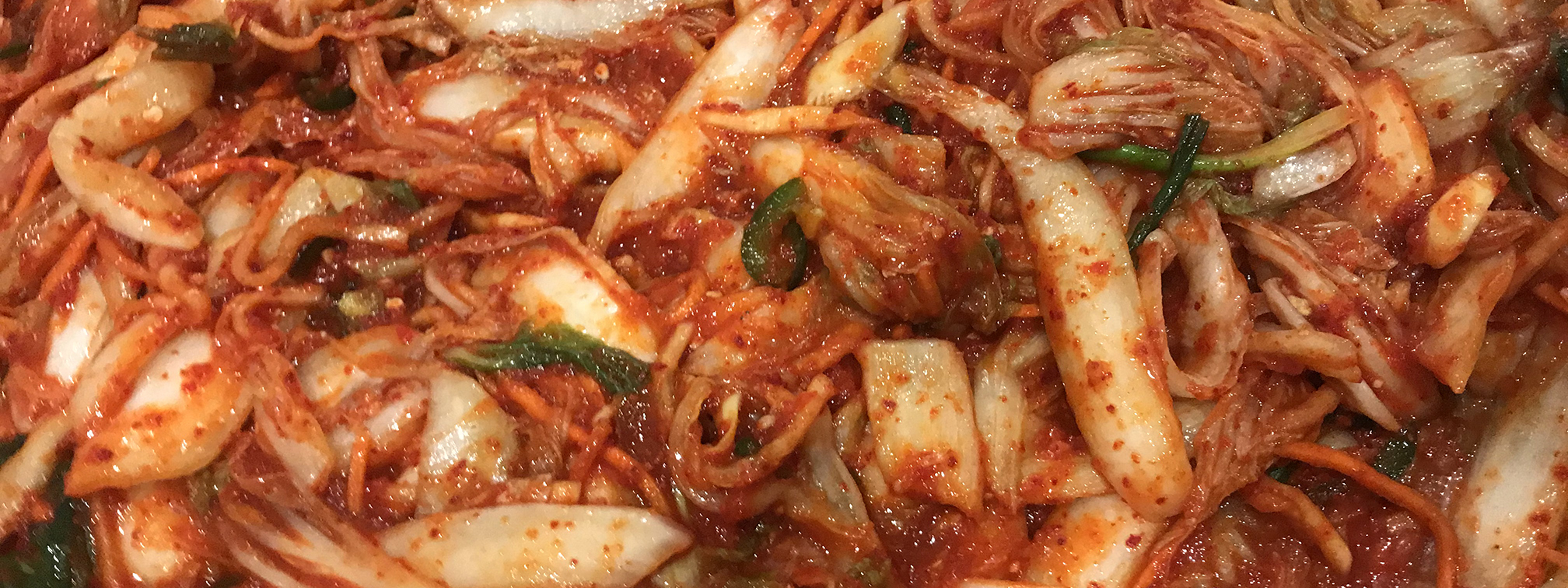THE KIMCHI

What’s In It?
Our kimchi contains: Napa Cabbage, Korean Daikon, Carrots, Fresh Peppers, Ground Dried Pepper, Onions, Scallions, Salted Shrimp, Fish Sauce (Anchovy Extract, Salt, Water, Fructose & Hydrolysed Vegetabble Protein), Rice Flour, Sugar, and Salt.
Allergen Warning: Those with allergens to shellfish or fish should not consume this product.
The Origin
Once every other month, Daniel woke up to find his mother busily starting her day by setting up her large tubs for a huge batch of kimchi. With Napa cabbage piled high, Sohi prepared all her ingredients, for the day long endeavor. Always curious about cooking, Daniel watched intently learning every nuance of his mother’s techniques. Eager to help, Daniel grabbed ingredients for his mother at her request, pouring salt or sugar into her hands which she used as measuring cups. She always knew just the right amount to use, sometimes a palm, sometimes a handful. She mixed the cabbage and red pepper mixture adjusting the flavors until it was just right. Then she would fold one kimchi leaf in her hand and feed it straight into Daniel’s mouth. MMmmm, briny, spicy and sweet flavors with a crisp salted cabbage always hit the spot.
Those memories are what inspired Daniel to create Sohi kimchi and share his mother’s beloved kimchi with his friends, family and now everyone.
The recipe for Sohi kimchi originated from the homemade recipe that Daniel grew up on with the approval of Sohi herself.
How To Eat Kimchi
Most people know kimchi as a small side dish given at korean bbq restaurants. However many people don’t know how diverse kimchi can be. Kimchi tastes great fresh as well as fermented.
Kimchi is a great accompaniment to any dish that is lacking in flavor or needs a spicy kick. Made fresh, kimchi is great with sliced uncured pork, tofu, rice.
After about a week and a half, as the kimchi ferments the spiciness tends to mellow and a sourness adds over time. In this stage kimchi can be eaten with just about anything: Tacos, Burritos, Pizza, Burgers and Sandwiches, Pasta, Any Noodles, or Soups. It goes great with meats and veggies alike.
After about a month and a half, the kimchi may be too sour for some to eat straight out of the jar. In this stage kimchi is still great for cooking. Since the flavors have now been absorbed into the cabbage, the kimchi is perfect for kimchi pancakes, kimchi fried rice, and a plethora of stews and soups ranging from korean guks and jjigaes to hot pots to korean style crab boils.
How To Store Kimchi
Always keep your kimchi in the refridgerator in an airtight sealed container. Properly stored kimchi can keep for up to 12 months.
Pro tip: If your container is small enough, it is recommended to put your container inside a large freezer bag to reduce the chance of leaks, spillage or escaping fermentation gas.
Fresh Kimchi Note: If you purchase fresh kimchi, be sure to burp (open the lid to release gas) the container every 3 days until enough kimchi is eaten so there is at least 2 inches of space between the top of the kimchi inside and the lid. This is to ensure there is no leaking or overage from fermentation gas buildup.
Health Benefits
There has been many studies done on the health benefits of kimchi with links to heart health, boosting the immune system, inflamation reduction, improved memory and antibacterial properties just to name a few.
- Kimchi is naturally probiotic and promotes digestion as it contains prebiotics and regulates cholesterol due to the presence of garlic.
- Kimchi also helps in weight loss as it is a good source of healthy lactobacillus bacteria. (Is that why all those K-Pop stars are so skinny?)
- Kimchi poses anti-aging properties as it contains antioxidants and vitamin C. (So that’s why my mom looks so young.)
But don’t take our word for it:
Kinds of Kimchi
There are many different varieties of kimchi. The traditional and most common is the napa cabbage kimchi (Baechu Kimchi). Here is a list of other kimchis:
- Radish Cubed Kimchi (KKakdugi Kimchi)
- Leaf Mustard Kimchi (Gat Kimchi)
- “Ponytail” Radish Kimchi (Chonggak Kimchi)
- Green Water or Yeolmu Radish Kimchi (Yeolmumul Kimchi)
- Cucumber Kimchi (Oi-sabagi)
- White Kimchi (Baek Kimchi)
- Red Water Kimchi (Nabak Kimchi)
